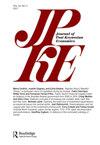Government spending with increasing risk: sovereign debt, liquidity preference, and the fiscal-monetary nexus
IF 1
3区 经济学
Q4 ECONOMICS
引用次数: 0
Abstract
AbstractDuring financial and economic crises, government expenditure is a potential source of liquidity and replacement for private demand; this expenditure, in turn, generates more deposits and spending in the economy at large, potentially increasing the endogenous supply of money and overall liquidity in a given economy. Governments may also require liquidity support during crises, if bond market activity constrains access to funding. This paper introduces government activity to Mott’s elaboration of Kalecki’s theory of increasing risk, and its implications for endogenous money creation, especially during periods of heightened liquidity preference. Some governments are likely to face greater obstacles in providing liquidity and accessing funding in times of economic uncertainty, whether due to their issuance of a non-sovereign currency, their position in the global currency hierarchy, or both, while others may find their ability to provide liquidity is bolstered by popular perceptions of their credit worthiness. Recent crises illustrate the importance of understanding the monetary and financial factors that may constrain governments’ abilities to fund deficits, especially given the importance of fiscal expenditure as a stabilizing economic force, or as a potential driver of development.Keywords: RiskliquidityPost Keynesianendogenous moneyfiscal policy AcknowledgementsI gratefully acknowledge feedback from two anonymous reviewers, participants in the Analytical Political Economy Workshop in May 2021, participants at the Inaugural Tracy Mott Workshop at the University of Denver, in September 2022, and panel participants at the Money as a Democratic Medium conference in June 2023. I accept all responsibility for any remaining errors in the text.Disclosure statementNo potential conflict of interest was reported by the author(s).Notes1 Examples include the central banks of Canada, the United States, the UK, Japan, the Eurozone, India, Korea, the Philippines, Thailand, Indonesia, Hungary, Israel, Poland, Romania, South Africa, Turkey, Mexico, Brazil, Chile, and Colombia (Cantú et al. Citation2021).2 Bell (Citation2000) notes that in the US, if the US government’s Treasury Department uses Treasury Deposit accounts for purchases and sale of bonds, total money in circulation may not be affected, because those institutions are not required to maintain proportional reserves. This example assumes a more general case in which the sale of a bond precedes expenditure.3 Neo-chartalists object to the notion that a government may require funding, arguing instead that tax revenues or revenue from selling bonds merely takes money out of circulation (Bell Citation2000). For the purposes of this paper, we assume that taking money out of circulation has the same effect as funding expenditure, insofar as it balances the government’s spending in the economy. At the same time, the government of a non-currency sovereign economy may require foreign exchange for expenditure funded by bonds.Additional informationNotes on contributorsNina EichackerNina Eichacker is an Assistant Professor in the Economics Department at the University of Rhode Island. Her work focuses on Post Keynesian theory, financial crisis, liquidity, and the interaction of fiscal and monetary policies.风险增加的政府支出:主权债务、流动性偏好和财政-货币关系
摘要在金融和经济危机中,政府支出是流动性的潜在来源和私人需求的替代;这种支出反过来又在整个经济中产生更多的存款和支出,潜在地增加了特定经济体的内生货币供应和总体流动性。在危机期间,如果债券市场活动限制了融资渠道,政府也可能需要流动性支持。本文将政府活动引入莫特对卡莱茨基风险增加理论的阐述,以及它对内生货币创造的影响,特别是在流动性偏好加剧的时期。在经济不确定时期,一些政府可能会在提供流动性和获取资金方面面临更大的障碍,无论是由于它们发行了非主权货币,还是由于它们在全球货币体系中的地位,或者两者兼而有之,而另一些政府可能会发现,它们提供流动性的能力得到了公众对其信用价值的认可。最近的危机说明了理解货币和金融因素的重要性,这些因素可能会限制政府为赤字提供资金的能力,特别是考虑到财政支出作为稳定经济的力量或作为发展的潜在驱动力的重要性。致谢致谢致谢致谢致谢致谢致谢致谢致谢致谢致谢致谢致谢致谢致谢致谢致谢致谢致谢致谢致谢致谢致谢致谢致谢致谢致谢致谢致谢致谢致谢致谢致谢致谢致谢致谢致谢致谢致谢致谢致谢致谢致谢致谢致谢致谢致谢致谢致谢致谢致谢致谢致谢致谢致谢致谢致谢致谢致谢致谢致谢致谢致谢致谢致谢致谢致谢致谢致谢致谢致谢致谢致谢致谢致谢致谢致谢致谢致谢致谢致谢致谢致谢致谢致谢致谢致谢致谢致谢致谢致谢致谢致谢致谢致谢致谢致谢致谢致谢致谢致谢致谢致谢致谢致谢致谢致谢致谢致谢致谢致谢致谢致谢致谢致谢致谢致谢致谢致谢致谢致谢致谢致谢致谢致谢致谢我对文中的任何错误承担全部责任。披露声明作者未报告潜在的利益冲突。注1示例包括加拿大、美国、英国、日本、欧元区、印度、韩国、菲律宾、泰国、印度尼西亚、匈牙利、以色列、波兰、罗马尼亚、南非、土耳其、墨西哥、巴西、智利和哥伦比亚(Cantú等)的中央银行。Citation2021)。2Bell (Citation2000)指出,在美国,如果美国政府的财政部使用国库存款账户购买和出售债券,流通中的总货币可能不会受到影响,因为这些机构不需要保持一定比例的准备金。这个例子假设了一种更一般的情况,即债券的销售先于支出新宪章主义者反对政府可能需要资金的观点,他们认为,税收收入或出售债券的收入只是将资金从流通中取出(贝尔引用2000)。为了本文的目的,我们假设将货币从流通中撤出与资助支出具有相同的效果,因为它平衡了政府在经济中的支出。与此同时,非货币主权经济体的政府可能需要外汇来支付由债券资助的支出。作者简介:nina Eichacker是罗德岛大学经济系的助理教授。她的研究重点是后凯恩斯理论、金融危机、流动性以及财政和货币政策的相互作用。
本文章由计算机程序翻译,如有差异,请以英文原文为准。
求助全文
约1分钟内获得全文
求助全文
来源期刊

Journal of Post Keynesian Economics
ECONOMICS-
CiteScore
1.70
自引率
10.00%
发文量
23
期刊介绍:
The Journal of Post Keynesian Economics is a scholarly journal of innovative theoretical and empirical work that sheds fresh light on contemporary economic problems. It is committed to the principle that cumulative development of economic theory is only possible when the theory is continuously subjected to scrutiny in terms of its ability both to explain the real world and to provide a reliable guide to public policy.
 求助内容:
求助内容: 应助结果提醒方式:
应助结果提醒方式:


